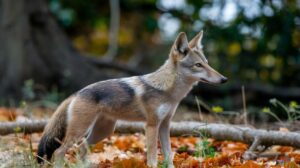Introduction
Imagine a hyena, but instead of scavenging carcasses and hunting prey, it slurps up termites with a sticky tongue. Meet the aardwolf (Proteles cristata), a fascinating and often misunderstood member of the hyena family that has carved out a unique niche in the African ecosystem. This article delves into the aardwolf’s fascinating biology, behavior, and conservation status.

Table of Contents
Introduction
What is an Aardwolf?
Physical Characteristics
Taxonomy and Evolution
Diet and Behavior
Termite Specialist
Social Structure and Territory
Conservation Status and Threats
Conclusion
FAQ
What is an Aardwolf?
The aardwolf, meaning “earth wolf” in Afrikaans, is a small, nocturnal mammal found in the scrublands and open savannas of eastern and southern Africa. Despite its name and hyena lineage, its diet consists almost exclusively of insects, primarily termites.
Physical Characteristics
Aardwolves are significantly smaller than other hyenas. They typically weigh between 8 and 15 kilograms (18-33 lbs) and stand about 45-50 cm (18-20 inches) tall at the shoulder. Their coats are yellowish-brown with vertical black stripes, and they possess a long, bushy tail. A distinctive feature is their mane, which runs along their back and can be erected to make them appear larger and more intimidating when threatened. Their teeth are also unique; while they possess canines, their cheek teeth are reduced and peg-like, suited for grinding insects rather than tearing meat.
Taxonomy and Evolution
Aardwolves belong to the family Hyaenidae, which also includes the spotted hyena, brown hyena, and striped hyena. While all hyenas share a common ancestor, the aardwolf diverged from the other species millions of years ago, evolving its specialized insectivorous diet. Its scientific name, Proteles cristata, translates to “complete in front crested,” referring to its complete set of teeth compared to the more reduced dentition of other insectivores. Fossil evidence suggests that the aardwolf lineage dates back to the Pliocene epoch.
Diet and Behavior
Termite Specialist
The aardwolf’s diet is almost entirely composed of termites, specifically Trinervitermes species, which are small, harvester termites that forage on the surface at night. Aardwolves use their long, sticky tongues to lap up these termites, consuming thousands in a single feeding session. They are highly selective in their choice of termites and avoid soldier termites, which have a defensive bite. Unlike other hyenas, aardwolves do not scavenge or hunt large prey, and their digestive system is adapted for processing insects.
Social Structure and Territory
Aardwolves typically live in monogamous pairs, establishing territories that they defend against other pairs. Territories are marked with scent secretions from anal glands. While they often forage alone, aardwolves will share a den with their mate and offspring. Young aardwolves remain with their parents for about a year, learning foraging techniques and social skills. They are primarily nocturnal, spending the day in underground burrows or dense vegetation to avoid predators.
Conservation Status and Threats
The aardwolf is currently listed as Least Concern by the International Union for Conservation of Nature (IUCN). However, they face several threats, including habitat loss due to agriculture and urbanization, persecution by farmers who mistakenly believe they prey on livestock, and accidental poisoning from insecticides used to control termites. While not currently endangered, continued monitoring and conservation efforts are necessary to ensure the long-term survival of this unique species. Conservation strategies include educating local communities about the aardwolf’s beneficial role in controlling termite populations and protecting their habitat from degradation.
Conclusion
The aardwolf stands as a remarkable example of evolutionary adaptation. This insectivorous hyena relative plays a vital role in its ecosystem by controlling termite populations. While currently not endangered, ongoing threats highlight the importance of conservation efforts. By understanding and appreciating the aardwolf, we can contribute to the preservation of biodiversity and the delicate balance of the African savanna. Consider supporting organizations dedicated to wildlife conservation in Africa to help protect the aardwolf and its habitat.
FAQ
* Are aardwolves dangerous to humans or livestock?
No, aardwolves are not dangerous. They are shy and primarily eat insects, posing no threat to humans or livestock.
* How do aardwolves find termites?
Aardwolves have excellent hearing and can detect the sounds of termites foraging underground. They also use their sense of smell to locate termite mounds.
* What is the difference between an aardwolf and an aardvark?
Aardwolves and aardvarks are completely unrelated animals. Aardvarks are more closely related to elephants and are also insectivores, but they are much larger and have a different body structure.
* Where can I see an aardwolf in the wild?
Aardwolves are nocturnal and relatively shy, making them difficult to spot. However, they can be found in protected areas and national parks in eastern and southern Africa, such as the Serengeti National Park in Tanzania and the Kruger National Park in South Africa.
* What can I do to help protect aardwolves?
Support organizations that work to conserve wildlife and protect their habitats. Educate others about the importance of biodiversity and the role that aardwolves play in the ecosystem.
